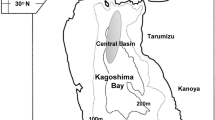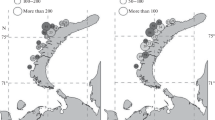Abstract
We studied some aspects of the population dynamics of the yellow clam Mesodesma mactroides (Deshayes, 1854) which inhabits the eastern sandy beaches of Uruguay. Observations were made from March 1983 through March 1985 (harvesting season), and additional data from January 1988 to December 1989 (closed season) were also included in the analyses. Parameters of growth and mortality were estimated by methods that make use of age or length information. An age/length relationship was constructed by counting growth rings. Results were consistent with those obtained with modal class progression analysis and other length/frequency methods. The growth curve obtained from the age/length relationship did not account for seasonality in growth rate, and a seasonal growth model explained growth oscillations in a better way. The instantaneous coefficient of natural mortality (M) estimated for the closed season was 1.64, whereas an increase in fishing mortality (F) was observed during 1984. Age composition did not change during the 2 yr of study, and the first 6 mm class accounted for over 50% of the population. The main contribution of recruits was observed between late summer and early fall (February to April), and the recruitment pattern suggested one main settlement period per year. Growth and recruitment success appeared to be regulated by density-dependence processes. Some implications for management are considered in this context. Methodological aspects concerning the reliability of empirical equations and programs for estimating growth and mortality are discussed.
Similar content being viewed by others
Literature cited
Arntz, W. E., Brey, T., Tarazona, J., Robles, A. (1987). Changes in the structure of a shallow sandy-beach community in Peru during an El Niño event. In: Payne, A. I. L., Gulland, J. A., Bink, K. H. (eds.) The Benguela and comparable ecosystems. S. Afr. J. mar. Sci. 5: 645–658
Basson, M., Rosenberg, A. A., Beddington, J. R. (1988). The accuracy and reliability of two new methods for estimating growth parameters from length frequency data. J. Cons. int. Explor. Mer. 44: 277–285
Bertalanffy, L. von (1938). A quantitative theory of organic growth. Hum. Biol. 10: 181–213
Brown, A. C., McLachlan, A. (1990). Ecology of sandy shores. Elsevier Science Publishers, Amsterdam
Carcelles, A. (1939). Pectunculus longior y Mesodesma mactroides de la Argentina y Uruguay. Physis, B. Aires 17: 736–743
Cassie, S. E. (1954). Some uses of probability paper in the analysis of size frequency distributions. Aust. J. mar. Freshwat. Res. 5: 513–522
Castellanos, Z. A. (1948). Estudio anatómico sobre Mesodesma mactroides Desh. (almeja amarilla). Dirección Agropecuaria, Publ. Téc. 5(1): 3–49
Castilla, J. C., Paine, R. (1987). Predation and community organization on Eastern Pacific, temperate zone, rocky intertidal shores. Revta chil. Hist. nat. 60: 131–151
Chapman, D. G., Robson, D. S. (1960). The analysis of a catch curve. Biometrics 16: 354–368
Coe, W. R. (1953). Resurgent populations of littoral marine invertebrates and their dependence on ocean currents and tidal currents. Ecology 34: 225–229
Coe, W. R. (1956). Fluctuations in populations of littoral marine invertebrates. J. mar. Res. 15: 212–232
Coscaron, S. (1959). La almeja amarilla (Mesodesma (T.) mactroides Deshayes) de la costa de la Provincia de Buenos Aires. Agro Publ. Tec. 1 (3): 1–66
De Alava, A., Defeo, O. (1991). Distributional pattern and population dynamics of Excirolana armata (Isopoda: Cirolanidae) in a Uruguayan sandy beach. Estuar. cstl Shelf Sci 33: 433–444
Defeo, O. (1985a). Aspectos biocenológicos y de dinámica de población de “almeja amarilla” Mesodesma mactroides (Deshayes, 1854) en la zona de la Barra del Chuy, Depto. de Rocha, Uruguay. I. Biocenología. Contr. Depto. Oceanogr. (F.H.C.), Montevideo, Uruguay 2: 50–75
Defeo, O. (1985b). Aspectos biocenológicos y de dinámica de población de “almeja amarilla” Mesodesma mactroides (Deshayes, 1854) en la zona de la Barra del Chuy, Depto. de Rocha, Uruguay. II. Dinámica de la población. Contr. Depto. Oceanogr. (F.H.C.) Montevideo, Uruguay 2: 76–98
Defeo, O. (1987). Consideraciones sobre la ordenación de una pesquería en pequeña escala. Biol. Pesq. 16: 47–62
Defeo, O. (1988). Dinámica poblacional de la almeja amarilla Mesodesma mactroides en playas de la costa atlántica uruguaya. Simposio sobre Pesquisa Pesqueira, Rio Grande, Brazil (Abstract)
Defeo, O. (1989). Development and management of artisanal fishery for yellow clam Mesodesma mactroides in Uruguay. Fishbyte 7(3): 21–25
Defeo, O., Areguin-Sanchez, F., Sanchez, J. (in press). Growth study of the yellow clam Mesodesma mactroides: a comparative analysis of three length-based methods. Scientia Marina (Spain)
Defeo, O., Layerle, C., Masello, A. (1986). Spatial and temporal structure of the yellow clam Mesodesma mactroides population in Uruguay. Medio ambiente 8: 48–57
Defeo, O., Masello, A., Layerle, C. (1988a). Consideraciones metodológicas para el estudio del creciminento en moluscos bivalvos. Inf. Unesco Cienc. Mar 47: 135–148
Defeo, O., Rey, M., Cascudo, J. (1988b). Estimaciones de stock del recurso Mesodesma mactroides en base al análisis de cohortes (Pope, 1972). Publ. Com. Téc. Mix. Fr. Mar. 4: 41–54
Defeo, O., Scarabino, V. (1990). Ecological significance of a possible deposit-feeding strategy in Mesodesma mactroides (Deshayes, 1854) (Mollusca: Pelecypoda). Atlantica, Rio Grande 12(1): 55–65
Gallucci, V. F., Quinn, T. J. (1979). Reparametrizing, fitting and testing a simple growth model. Trans. Am. Fish. Soc. 108 (1): 14–25
Gayanilo, F. C., Jr., Soriano, M., Pauly, D. (1989). A draft guide to the complete ELEFAN. ICLARM Contribution No. 435, Metro Manila, Philippines
Gianuca, N. M. (1983). A preliminary account of the ecology of sandy beaches in southern Brazil. In: McLachlan, A., Erasmus, T. (eds.) Sandy beaches as ecosystems. W. Junk, The Hague, p. 413–420
Hancock, D. A. (1973). The relationship between stock and recruitment in exploited invertebrates. Rapp. P.-v. Réun. Cons. int. Explor. Mer. 164: 113–131
Harding, J. P. (1949). The use of probability paper for the graphical analysis of polymodal frequency distributions. J. mar. biol. Ass. U.K. 28: 141–153
Hoenig, J. M. (1983). Empirical use of longevity data to estimate mortality rates. Fish. Bull. U.S. 81: 898–903
Hoenig, J. M., Hanumara, R. C. (1982). A statistical study of a seasonal growth model for fishes. Tech. Rep., Dept. of Computer Science and Statistics, University of Rhode Island, Kingston
Hoenig, J. M., Hanumara, R. C. (1990). An empirical comparison of seasonal growth models. Fishbyte 8(1): 32–34
Lutz, R. A., Rhoads, D. C. (1980). Growth patterns within the molluscan shell. An overview. In: Rhoads, D. C., Lutz, R. A. (eds.) Skeletal growth of aquatic organisms. Plenum Press, New York, p. 203–254
Masello, A. (1987). Consideraciones sobre crecimiento y biología reproductiva de la almeja amarilla Mesodesma mactroides (Deshayes, 1854). M. Sc. Thesis, Universidad de la República, Montevideo, Uruguay
Masello, A., Defeo, O. (1986). Determinación de la longitud de primera madurez sexual en Mesodesma mactroides (Deshayes, 1854). Com. Soc. Malac. Uruguay 6: 387–392
Moreau, J. (1987). Mathematical and biological expression of growth in fishes. Recent trends and further developments. In: Summerfelt, R. C., Hall, G. E. (eds.) The age and growth of fish. Iowa State University Press, Ames, Iowa, p. 81–113
Narchi, W. (1981). Aspects of the adaptive morphology of Mesodesma mactroides (Bivalvia: Mesodesmatidae). Malacologia 21 (1/2): 95–110
Olivier, S., Capezzani, D., Carreto, J., Christiansen, H., Moreno, V., de Moreno, J. A., Penchaszadeh, P. (1971). Estructura de la comunidad, dinámica de la población y biología de la almeja amarilla (Mesodesma mactroides) en Mar Azul. Proyecto Desarrollo Pesq. Ser. Inf. Tec. Publ. 27: 1–90
Olivier, S., Penchaszadeh, P. (1968). Efectivos de almeja amarilla (Mesodesma mactroides) en las costas de la Provincia de Buenos Aires y pautas para su explotación racional. Proyecto Desarrollo Pesq. Ser. Inf. Tec. Publ. 8: 1–6
Orensanz, J. M. (1986). Size, environment, and density: the regulation of a scallop stock and its management implications. In: Jamieson, G. S., Bourne, N. (eds.) North Pacific workshop on stock assessment and management of invertebrates. Can. Spec. Publ. Fish. aquat. Sciences 92: 195–227
Orensanz, J. M., Parma, A. M., Iribarne, O. O. (1991). Population dynamics and management of natural stocks. In: Shumway, S. E. (ed.) Scallops: biology, ecology and aquaculture. Developments in aquaculture and fisheries science, vol. 21. Elsevier, Amsterdam, p. 625–713
Pauly, D. (1983). Algunos métodos simples para la evaluación de recursos pequeros tropicales. F.A.O. Fish tech. Pap. (234): 1–49
Pauly, D., Caddy, J. F. (1985). A modification of Battacharya's method for the analysis of mixtures of normal distributions. F.A.O. Fish. Circ. (781): 1–16
Pauly, D., Gaschütz, G. (1979). A simple method for fitting oscillating length growth data, with a program for pocket calculators. Int. Coune. Explor. Sea Comm. Meet. (Demersal Fish Comm.) G24 24: 1–26 (mimeo)
Pauly, D., Ingles, J., Neal, R. (1984). Application to shrimp stocks of objective methods for the estimation of growth, mortality and recruitment related parameters from length — frequency data (ELEFAN I and II). In: Gulland, J. A., Rothschild, B. J. (eds.) Penaeid shrimps, their biology and management. Fishing News Books, Farnham, Surrey, England, p. 220–234
Possingham, H. P., Roughgarden, J. (1990). Spatial population dynamics of a marine organism with a complex life cycle. Ecology 71(3): 973–985
Ricker, W. E. (1973). Linear regressions in fishery research. J. Fish. Res. Bd Can. 30: 409–434
Rikhter, V., Efanov, V. (1976). On one of the approaches to estimation of natural mortality of fish populations. Spec. Publs int. Commn NW Atlant. Fish 6 (8): 1–12
Ropes, J. W., Jearld, A., Jr., (1987). Age determination of ocean bivalves. In: Summerfelt, R. C., hall, G. E. (eds.) Age and growth of fish. Iowa State University Press, Ames, Iowa, p. 517–526
Roughgarden, J., Gaines, S., Possingham, H. (1988). Recruitment dynamics in complex life cycles. Science, N.Y. 241: 1460–1466
Roughgarden, J., Iwasa, Y., Baxter, C. (1985). Demographic theory for an open maríne population with spacè — limited recruitment. Ecology 66: 54–67
Shepherd, J. G. (1987a). A weakly parametric method for the analysis of length composition data. In: Pauly, D., Morgan, G. P. (eds.) Length-based methods in fisheries research. ICLARM Conf. Proc. 13, Manila, p. 113–119
Shepherd, J. G. (1987b). Towards a method for short-term forecasting of catch rates based on length compositions. In: Pauly, D., Morgan, G. P. (eds.) Length-based methods in fisheries research. ICLARM Conf. Proc. 13, Manila, p. 167–176
Somers, I. F. (1988). On a seasonally oscillating growth function. Fishbyte 6(1): 8–11
Soriano, M. L. (1987). Separation of mixture distribution into its Gaussian components. Master of Statistics Thesis. University of the Philippines, Makati, Metro Manila, Philippines
Stamatopoulos, C., Caddy, J. F. (1989). Estimation of von Bertalanffy growth parameters: a versatile linear regression approach. J. Cons. int. Explor. Mer 45: 200–208
Tarifeño, E. (1980). Studies on the biology of the surf clam Mesodesma donacium (Lamarck, 1818) (Bivalvia, Mesodesmatidae) from Chilean sandy beaches. Ph. D. Dissertation, University of California, Los Angeles, U.S.A.
Author information
Authors and Affiliations
Additional information
Communicated by O. Kinne, Oldendorf/Luhe
Rights and permissions
About this article
Cite this article
Defeo, O., Ortiz, E. & Castilla, J.C. Growth, mortality and recruitment of the yellow clam Mesodesma mactroides on Uruguayan beaches. Marine Biology 114, 429–437 (1992). https://doi.org/10.1007/BF00350034
Accepted:
Issue Date:
DOI: https://doi.org/10.1007/BF00350034




